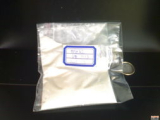- Search Product
-
-
- Region :Agrochemicals/Fungicide
- Tel : 15137105706
- Fax : +86-371-66819620
- Email :rd@pesticidechina.com
- URL :www.pesticidechina.com
- Details for China Azoxystrobin
-
Azoxystrobin 131860-33-8
Category : Agrochemicals/Fungicide

CAS NO : 131860-33-8 EC NO : MF : C22H17N3O5 MW : 403.3875 Specification : 95%TC 25%SC 50%WDG Packing : 25kg fiber drum Product description : Description:
Appearance: White crystalline powder
Melting Point: 83-84 °C.
Vapour Pressure: 0.30m Pa at 25°C.
Stability : It is soluble in water (15.4 g/1000 ml in water at 25°C)and some organic solvents.It hydrolyzes into dichlorvos in alkaline medium.It is umstable at high temperature.
Specification : 95%TC 25%SC 50%WDG
Uses: It is a broad spectrum insecticide with stomach poisoning,contact action.It is mainly used on vetetables,fruit trees,tea,mulberry,cotton and rice against various pests,also against public health pests and parasites of domestic animal.In practise,the product has rather better effectiveness on diseases of fish.Common nameazoxystrobin Product category Fungicide Chemical name methyl (E)-2-{2-[6-(2-cyanophenoxy)pyrimidin-4-yloxy]phenyl}-3-methoxyacrylate CAS Number 131860-33-8 Molecular formula C22H17N3O5
?application Biochemistry
Inhibits mitochondrial respiration by blocking electron transfer between cytochrome b and cytochrome c1, at the ubiquinol oxidising site. Controls pathogenic strains resistant to the 14-demethylase inhibitors, phenylamides, dicarboxamides or benzimidazoles.
Mode of action
Fungicide with protectant, curative, eradicant, translaminar and systemic properties. Inhibits spore germination and mycelial growth, and also shows antisporulant activity.
Uses
Controls the following pathogens at application rates between 100 to 375 g/ha: Erysiphe graminis, Puccinia spp., Leptosphaeria nodorum, Septoria tritici and Pyrenophora teres on temperate cereals; Pyricularia oryzae and Rhizoctonia solani on rice; Plasmopara viticola and Uncinula necator on vines; Sphaerotheca fuliginea and Pseudoperonospora cubensis on cucurbitaceae; Phytophthora infestans and Alternaria solani on potato and tomato; Mycosphaerella arachidis, Rhizoctonia solani and Sclerotium rolfsii on peanut; Monilinia spp. and Cladosporium carpophilum on peach; Pythium spp. and Rhizoctonia solani on turf; Mycosphaerella spp. on banana; Cladosporium caryigenum on pecan; Elsino?fawcettii, Colletotrichum spp. and Guignardia citricarpa on citrus; Colletotrichum spp. and Hemileia vastatrix on coffee.
Phytotoxicity
Good crop safety, except on some varieties of apple (e.g. McIntosh, Cox).
Formulation types
SC; WG.; GR; SE.Uses : It is a broad spectrum insecticide with stomach poisoning,contact action.It is mainly used on vetetables,fruit trees,tea,mulberry,cotton and rice against various pests,also against public health pests and parasites of domestic animal.In practise,the produ Synonyms : Methyl (E)-2-((6-(2-cyanophenoxy)-4-pyrimidinyl)oxy)-alpha-(methoxymethylene)benzeneacetate;Pyroxystrobin;Methyl (E)-2-((6-(2-cyanophenoxy)-4-pyrimidinyl)oxy)-alpha- (methoxymethylene) benzeneacetate;amista;methyl (2E)-2-(2-{[6-(2-cyanophenoxy)pyrimidin-4-yl]oxy}phenyl)-3-methoxyprop-2-enoate; Molecular Structure : 